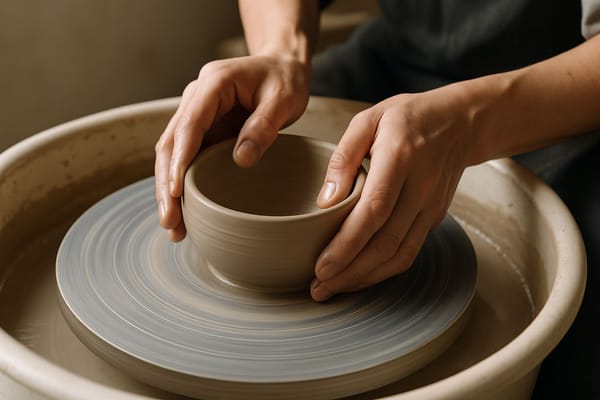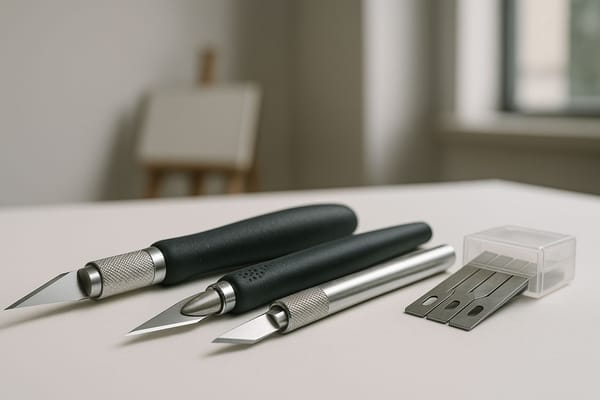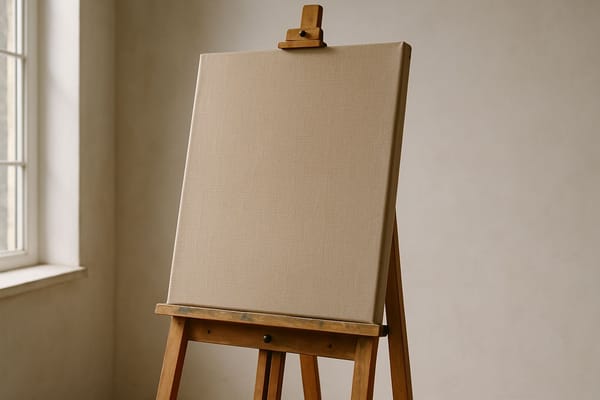How to Choose the Right Flat File Cabinet for Art, Blueprints, and Drawings?
Find the perfect flat file cabinet for your artwork and plans. Compare materials, sizes, and features to choose smarter.
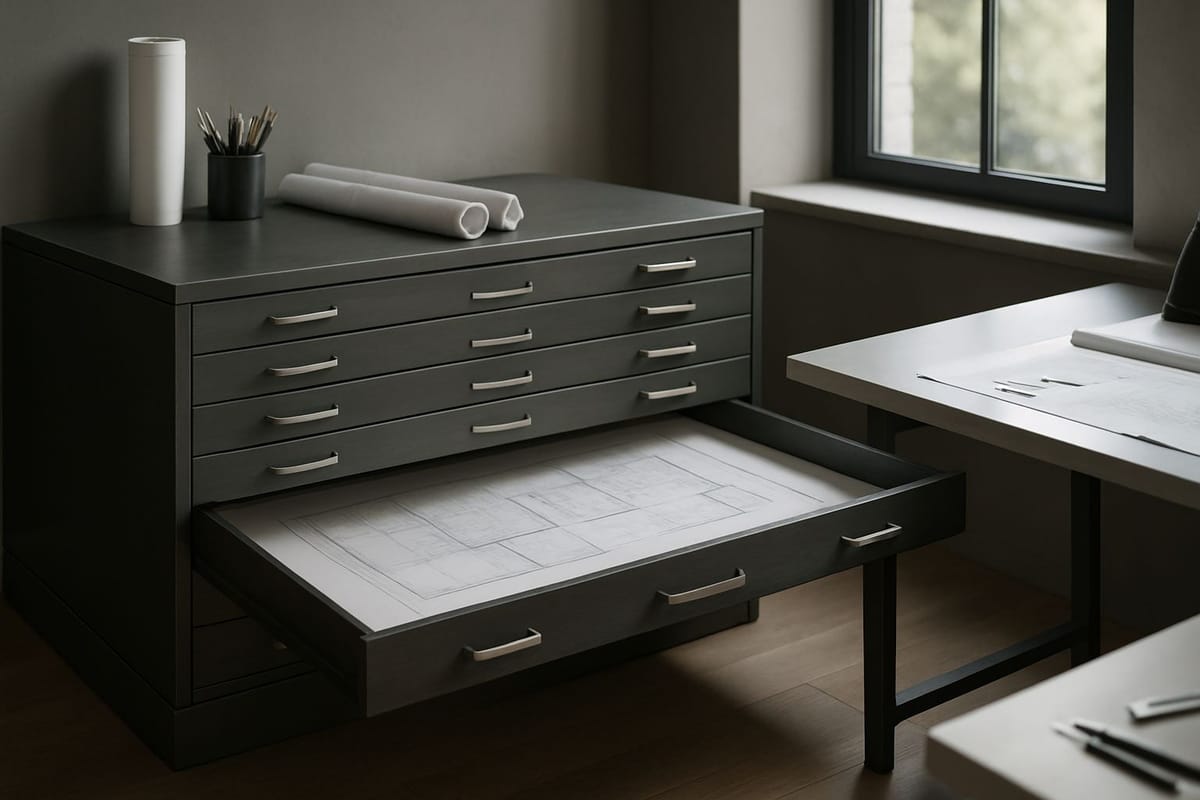
Large papers need the storage that ensures their flattening, cleanliness, and ease of location. This is a place where an intelligently selected cabinet facilitates the day-to-day job of artists, architects, and designers. This tutorial explains how to choose the right build, size, and features for your studio. You are going to study the advantages and disadvantages of material, planning space, and maintenance basics.
What Is a Flat File Cabinet?
A Flat File Cabinet is a shallow system of drawers designed to hold a large sheet of paper, which is not to be folded or rolled. Its major characteristics are low-profile drawers that glide smoothly and labelled windows for easy retrieval. Many models feature additional locking, interlocking safety, and roomy additions to expand collections.
Also, flat drawers will get curled edges and pressed corners more effectively than deep and general-purpose furniture. There is no scraping of sheet goods, and no reason to look at titles. It is much quicker to retrieve, as every drawer has only a single layer.
The protection is better when the paper is laid flat on the smooth surface. Drawers are closed to protect dust, light, and casual handling. Stable cases reduce vibrations and swings in moisture, resulting in more durable and delicate media and mounted works.
What Are the Different Types of Flat File Cabinets?
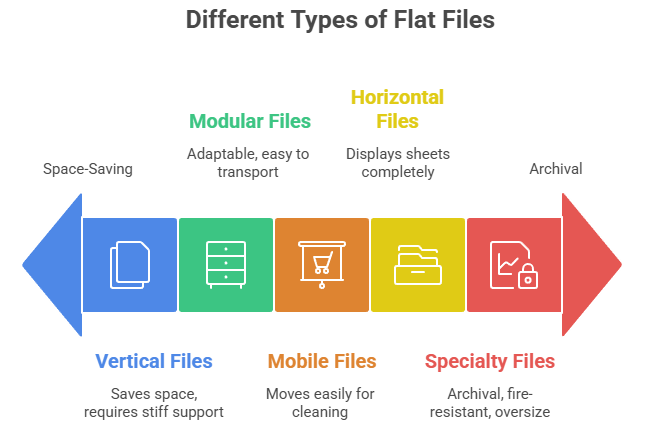
The most popular flat file cabinet formats are horizontal and vertical, stackable modular, with casters on a mobile base, and archival or oversized models. The space, sheet size, and frequency of opening any given drawer are some of the determinants of your choice. Begin with the footprint you can sustain, and strategize for more room.
Horizontal Flat Files
Horizontal units have large, shallow drawers that display sheets completely.
Vertical Flat Files
Vertical files position the items along the edge of the slot or folders, thereby saving space but requiring stiffer support and careful handling.
Stackable modular flat files
Single drawer units are stacked to increase capacity over time. This form is more adaptable to the studio evolving and is easy to transport, as the parts are not as heavy as those in single-piece cases.
Mobile Flat Files
Cabinets placed on locking casters move in work zones, classrooms, or common studios. Mobility is useful when floors have to be cleaned or the layout has to be reconfigured frequently.
Specialty Flat Files
Neutral liners, sealed tops, and locking are added to the archival models. Large boards, maps, posters, etc., are done in oversize. Fire-resistant models safeguard the high-value documents.
Which Materials Are Best for Flat File Cabinets?
The best material is predominantly steel and hardwood, whereas laminates, aluminum, and archival plastics are used for specific purposes. Stability, weight, durability, and cost depend on the chosen material. Take into account the climate of your space and the amount of movement required for the cabinet.
- Powder-coated steel: Hale and hearty, firmly seated cases that slide smoothly and hold much inside, clean easily.
- Wood hardwood: Good appearance and strong structure, easy to repair, but a bit heavier and expensive.
- High-pressure laminate over core: Economical, not easily scratched or stained, and easy to carry.
- Aluminum frames: One that is lighter in weight but resistant to rust, which is useful in instances where one is on a mobile base, and in damp lines.
- Archival safe plastics or linens: Neutral, non-off-gassing contact of sensitive papers and photographs.
What Size and Capacity Do You Need for Your Work?
Space ought to be equal to your biggest sheets, in addition to space to mount and boards. Depth: Media thickness should not be crushed at the edges. Arrange to expand to ensure that drawers do not fill or become tight.
Common flat file cabinet sizes
- 24 x 36 inches: Fits small posters, student work, and most architectural sheets.
- 30 x 42 inches: envelopes typical maps and mid-size prints without any hazard.
- 36 x 48 inches: Large poster size, fine art documents, and drafting boards are suitable for this size.
- 40 x 60 inches: Moves large pieces of art and presentation boards.
- Custom oversize: Constructed using specialty formats and panorama prints or gallery mats.
How to Match Drawer Depth to Paper, Print, and Canvas Thickness?
Shallow one to two-inch-deep drawers are appropriate for paper, film, and thin boards. Matted prints and foam board are in medium depth. Options with deeper pays are used in portfolios and in rigid panels, and stacks are kept low to eliminate pressure marks.
Estimating the Right Number of Drawers for Growing Collections?
Determine the number of active projects and archived sets, and add at least two additional drawers. Load piles will be short to allow for moveable air and easy access. Assuming space is available, select a modular stack to add capacity in the future.
How to Organize and Label Flat File Drawers Efficiently
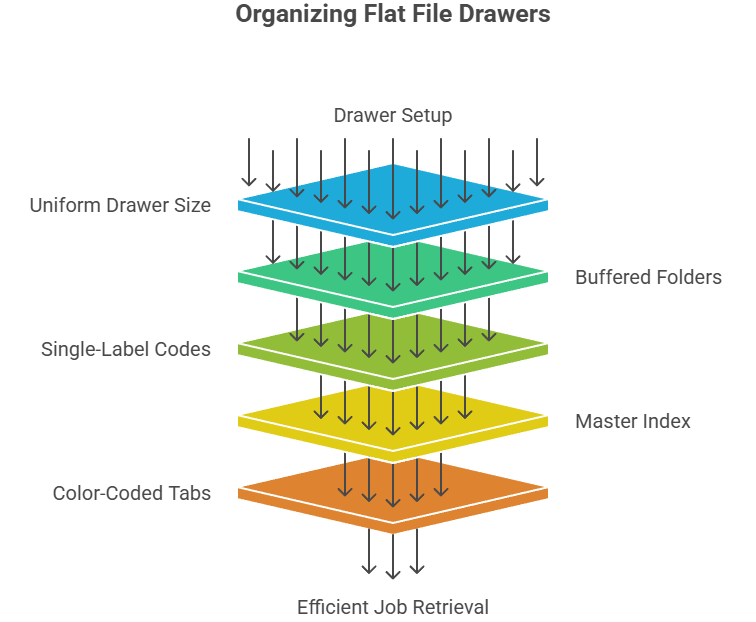
Definitive organization of your flat file cabinet accelerates the day-to-day activities and eliminates fatigue. Divide into groups by size, then by project, medium, or date. Apply simple labels that align with your search under the deadline.
- Each drawer is a single size to avoid mixed stacks and edge damage.
- Between the media materials lie buffered folders or sheets.
- Single-label codes containing project name, date, and sheet number.
- On the top drawer, a master index is available for quick reference.
- Urgent jobs are displayed in colour-coded tabs so they can be found in a second or two when needed.
What Features Should You Look for Before Buying a Flat File Cabinet?
You must focus on drawer action, safety, and security before appearance. Smooth slides, reliable stops, and stable bases matter most. Next, consider weight, stackability, finish, and comfort.
Drawer Smoothness, Weight Capacity, and Anti-Tilt Mechanisms
Full racking is free without being carried in trains. Rated capacities eliminate sagging and binding. Only one drawer can be opened at a time, and this is ensured by interlocks that keep the case steady.
Locking Systems for Valuable or Confidential Items
All the drawers are locked with the central locks, and keyed sets are used that make it easy to access all the cabinets. For shared space, use separate keys for sensitive projects.
Stackable vs Standalone Designs for Limited Studio Space
Increased workloads put more pressure on modular stacks. The standalone units are effective when height is insufficient or when seismic regulations apply. Inspect the levelling feet and top caps to ensure it is safe to stack.
Finish, Handles, and Overall Ergonomic Design
Hard-wearing finishes do not scuff and can be wiped down easily. Full-width handles are spaced, making pulling easy. Sharp edges are polished, and labels are easy to read, making daily life easier.
How to Care for and Maintain a Flat File Cabinet
Frequent maintenance is needed for the Flat files to ensure the smooth operation of the drawers. Install the cabinet directly on a flat surface, not against damp walls. Wipe soft and maintain a hardware check-up.
- Clean the outside of the dust-dry wine with a small, damp cloth.
- Use vacuum-drawers with a cleaning brush and do not use rough ones on linens.
- Check the slide every season, check the stop, screw; tighten, tighten.
- Change the liners and interlayering sheets to maintain surfaces.
- Shifting casters and levellers should not be left with debris to support smooth movement.
Final words
Prudent sizing, material, and feature matching in storage are making flat files an everyday productivity enhancement. It reflects on your way of searching, the way you store, and what will grow. So, wisely select a cabinet that safeguards the present and creates room for future projects.
Frequently Asked Questions
What's the difference between flat files and map cabinets?
The flat files are stored using shallow drawers. Map cabinets are either flat or slotted vertically. It is up to you based on the rigidity of the sheets and access means.
Can I Store Canvases or Boards in a Flat File?
Yes, provided that the drawers are deep enough and the slides are rated for the weight. Apply interleaving sheets and avoid creating heavy-looking piles on weak work.
How Do I Protect My Drawings From Humidity Inside Drawers?
A room where there is air movement and exterior walls should not be used. Insert archival interleaving, desiccant packs as necessary. Test the humidity using a basic gauge.
Are Flat File Cabinets Worth It for Home Studios?
Yes, when you're working with huge sheets. Returned time in retrieval will pay for itself in lower damage costs, despite a small model.
How Long Do Steel vs Wooden Flat Files Last?
The steel cases are extremely resistant to decades of stable slides. High-quality hardwood constructions are durable and reparable, though it may require additional maintenance of their finish and hardware.

